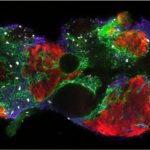About
We are excited to announce our newest Single Molecule, Real-Time sequencer, the Sequel™ System. Watch this short video to learn about this exciting evolution in SMRT® Sequencing.
The Sequel System provides higher throughput, more scalability, a reduced footprint and lower sequencing project costs compared to the PacBio® RS II System, while maintaining the benefits of SMRT technology. The core of the Sequel System is the capacity of its redesigned SMRT Cells, which contain one million zero-mode waveguides (ZMWs) at launch, compared to 150,000 ZMWs in the PacBio RS II. Active individual polymerases are immobilized within the ZMWs, providing windows to observe and record DNA sequencing in real time.
With about seven times as many reads per SMRT Cell as the PacBio RS II, customers should be able to realize lower costs and shorter timelines for sequencing projects, with approximately half the up-front capital investment compared to previous technology. The Sequel System occupies a smaller footprint — less than one-third the size and weight — compared to the PacBio RS II. Since the new system is built on the company’s established SMRT Technology, most aspects of the sequencing workflow are unchanged.
The Sequel System is ideal for projects such as rapidly and cost-effectively generating high-quality, whole-genomede novo assemblies for larger genomes, such as human, plants, and animals. It can provide characterization of a wide variety of genomic variation types, including those in complex regions not accessible with short-read or synthetic long-range sequencing technologies, while simultaneously revealing epigenetic information. The system can also be used to generate data for full-length transcriptomes and targeted transcripts using the company’s IsoSeq™ protocol. The Sequel System’s increased throughput should also facilitate applications of SMRT Technology in metagenomics and targeted gene applications for which interrogation of larger numbers of individual DNA molecules is important.
In a press release, Michael Hunkapiller, Ph.D., CEO of Pacific Biosciences, commented: “We are extremely proud to introduce the Sequel System, which provides access to the existing benefits of SMRT Sequencing, including long reads, high consensus accuracy, uniform coverage, and integrated methylation information — a set of core attributes first pioneered with the PacBio RS. The system’s lower cost and smaller footprint represent our continued commitment to leveraging the scalability of our technology and the unique characteristics of SMRT Sequencing.”
“We will continue to support our PacBio RS II customers, and we expect to introduce improvements in sample prep, sequencing chemistry, and software that will extend the performance of that system, as we have done each year since the initial commercialization of the PacBio RS in 2011 and the PacBio RS II in 2013. We expect to make similar, substantial performance improvements each year for the Sequel System,” added Dr. Hunkapiller. “In addition, the Sequel architecture provides the ability to scale throughput by substantially varying the number of ZMWs on future SMRT Cells, thereby optimizing throughput and operating costs for specific applications.”
For more information about the Sequel System, visit our new website


